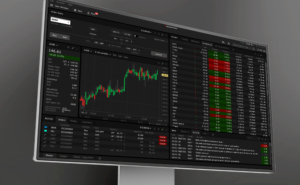In focus today
Today, Swedish Service PMIs for April are released at 8:30 CET. All its subindices were above the 50 marks in March. Although price index for raw materials and intermediate goods is lower compared to a year ago, it was still significantly higher compared to the manufacturing side. Composite PMI has been in expansionary territory for four consecutive months and thus further indicates a turnaround in the business cycle.
In the euro area, we look out for the March producer price index. Momentum in goods inflation has been very low in the past six months, and the PPI today will inform us about what we can expect going forward. Also, we follow the final euro area service PMI for April and the Sentix investor confidence indicator for May.
In the US, the Fed’s Q2 Senior Loan Officer Opinion Survey (SLOOS) is due for release in the evening. The survey will provide hints on how the Fed’s current policy stance is affecting demand for lending, which remained subdued in Q1.
Overnight, the Reserve Bank of Australia (RBA) will publish its rate decision. We expect no changes to the Cash Rate, in line with market pricing and consensus. Markets have pushed back their rate cut expectations significantly after the clear upside surprise in Q1 inflation data.
Looking ahead, we expect the Riksbank to keep the policy rate unchanged on Wednesday, and the BoE to keep the bank rate unchanged on Thursday. We also look for University of Michigan preliminary consumer sentiment for May on Friday. In a relatively quiet week on the data front, markets will be extra observant on Fedspeak. We are also set for Norwegian core CPI on Friday. Note that due to Ascension Day, there is no DMM on Thursday and Friday.
Economic and market news
What happened over the weekend
Peace talks in Cairo did not show progress over the weekend, with the Hamas delegation saying it would leave Sunday night, though they are set to return on Tuesday, Reuters reports. Hamas has been negotiating with mediators from Egypt and Qatar over the weekend. The main point of contention continues to be the withdrawal of Israeli troops from Gaza and an end to the war, with both sides blaming each other for the lack of progress.
What happened on Friday
Friday brought dovish signals for the Fed as the April NFP figure surprised to the downside (+175k, cons: +243k), while data for average hourly earnings and average weekly hours showed that growth in the total wage sum paid to workers stalled in April. Bonds continued their rally and the dollar lost steam, with the 10Y treasury down 15bp and DXY (broad dollar index) 1.2% weaker since Wednesday’s FOMC meeting. Oil prices also settled lower (Brent: 82.96 USD/bbl) on concerns of weaker demand, extending losses to 7% for the week.
Friday’s monetary policy statement from Norges Bank brought no game changers, as they kept their policy rate unchanged and largely maintained verbal guidance for the rate to stay at that level “for some time ahead”. We did get a slightly hawkish verbal shift, however, with the MPC acknowledging that developments since March could mean a hypothetically higher rate path.
Market movements
Equities: Global equity sentiment appeared to shift last week, but was it a genuine turnaround? Despite equities ending higher on Friday and for the week, the majority of the gains came towards the end of the week. Earnings were comparable, if not slightly weaker than previous weeks, and there were no significant changes in the geopolitical situation. However, yields shifted after the FOMC meeting on Wednesday and non-farm payroll (NFP) on Friday. The short end of the yield curve dropped almost 25bp and the long end almost 20bp from Wednesday to Friday, marking a significant shift from the trends observed in April. This shift impacted equity sentiment, but not the prevailing narrative. Unsurprisingly, with higher yields, small cap, tech, and growth outperformed, while the outperformance of utilities was more unexpected. On the US front on Friday, the Dow was up by 1.2%, S&P 500 by 1.3%, Nasdaq by 2.0%, and Russell 2000 by 1.0%. Asian markets are mostly higher this morning, and futures in Europe and the US are in the green.
FI: The weaker than expected US labour market data sent US bond yields lower on Friday. Hence, the 10Y US Treasury yield has declined almost 20bp from the peak seen in late April and are trading at 4.5%, while 2Y US Treasury yields trade at 4.8% down from 5%. European yields also declined as the 10Y German government bond yield declined some 10-12bp since late April and are now trading at 2.5%. Hence, our upper estimate for 2Y and 10Y Treasuries of 5% and 4.75% continue to hold as well as 2.75% for 10Y German government bonds.
FX: EUR/USD stabilised within the mid 1.07-1.08 range, briefly topping 1.08 following a weaker-than-expected US jobs report on Friday. Also, NOK had a strong finish to last week getting some much-needed support after having been among the outperformers in Majo’’s space so far this year (alongside SEK above and the JPY). The Reserve Bank of Australia (RBA) is widely expected to keep its cash rate unchanged early tomorrow morning by both analyst consensus and the markets. The big event in UK markets this week is the Bank of England (BoE) meeting on Thursday, where we expect EUR/GBP to end the day higher on a dovish vote split and remarks as well as a downward revision to the inflation forecast in the medium term.









